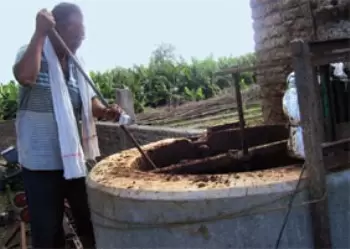Braving scepticism, two farmers show the world how effective biogas plants can be
15-December-2011
Vol 2 | Issue 50
When Vijay Ingle of Chittalwadi village in Akola district decided to install a biogas plant at his dairy last year, everyone was sceptical. It had failed to take off in the Vidarbha region despite the government promoting biogas as the cleanest and cheapest fuel for over three decades and offering subsidies for setting up the plant.
Besides, no one had heard of a biogas plant installed 400 metres from the house; it is usually set up in the backyard, close to the kitchen.
 |
|
The steely resolve of two Vidarbha farmers broke the myth that biogas plants will not work in their villages (Photo: Down to Earth)
|
In neighbouring Tandulwadi village of Buldhana district, farmer Shyamrao Deshmukh had faced similar scepticism four years ago. As his joint family grew and multiplied, they had to relocate their cowshed to the village outskirts, around half-a-kilometre away.
To cut down the growing LPG expenses, Deshmukh decided to set up a biogas plant in the cowshed. He, too, found himself surrounded by people asking him to give up the project.
The two farmers, however, stuck to their resolve and made the plants work. The success turned critics into believers. Today, Chittalwadi has 15 working biogas plants. Tandulwadi has four. Several others also plan to install biogas plants and have applied for subsidies.
So far, officials had cited cow dung scarcity in Vidarbha as the reason biogas was not drawing a crowd, despite subsidies. But farmers setting up biogas plants in these villages do not own large numbers of cattle, disproving the official theory. They have found innovative solutions to the challenges that prevented them from accessing biogas.
While struggling to overcome problems involving distance, Deshmukh approached Dr Punjabrao Deshmukh Krishi Vidyapeeth, an agriculture university in Akola that offers extension services.
He was advised to install telescoping PVC pipe to build pressure in the gas tank and put the pipeline below ground with a gentle gradient for unhindered flow of gas to the kitchen.
He was also told to install equipment for removing moisture from the pipeline. Deshmukh realised that to install the pipeline he would have to shell out more than the cost of the entire plant. He would also have to lower his kitchen floor by around 60 cm.
As he was about to give up, Deshmukh decided to try out his original plan. After all, he already had constructed a 2 cubic metre digester tank at Rs 9,000. Instead of PVC pipe, he installed a rubber pipe used for drip irrigation.
Instead of laying it underground, he took the pipe to his house by securing it to tree branches overhead. It cost him Rs 1,000. To trap moisture, he twisted the pipe into a loop at the source and secured it in that position; being heavier than gas, moisture settles within the loop and flows back into the digester.
“It has been four years but moisture, which the university official had warned would be the problem, has not troubled me,” Deshmukh says. The plant provides enough gas to cook for his family of six all year round.
Ingle had also approached the university for guidance but to no avail. Then he approached an agriculture input dealer, who suggested that he use rubber tubes used in LPG cylinders.
“My brothers and I had spent Rs 1.75 lakh for constructing four 6 cu m digester tanks,” says Ingle. “Installing that kind of a pipe would have cost us another Rs 1.4 lakh, which was impossible.”
Like Deshmukh, Ingle used a drip irrigation pipe, running overhead. But he bifurcated it at the source with a T-section. One branch carries the gas to the house, while the other heads vertically downwards to a nozzle. “I open it once a week to drain out moisture,” he says.
Apart from providing enough gas for cooking and heating bath water for 22 people, Ingle’s plant also provides enough gas for extra cooking for about 100 people three to four times a year during festivals, processing of 100 litres of milk products in the dairy every day, and lighting the cattle shed.
We are still left with surplus gas and plan to install a generator to supply power to the house,” says Ingle. His joint family now saves Rs 80,000 per year on LPG cylinders.
Most of the 15 farmers in Chittalwadi who used Ingle’s innovation own not more than three to four heads of cattle. “Initially, we were reluctant as the conventional biogas plant design requires a large amount of dung,” says Sindhutai Tayade, who owns four heads of cattle. “But when we found that Ingle’s plant works just by using dung from 10 to 12 animals, that too on alternate days, we thought it could work for us too.”
Milind Ingle, another farmer from Chittalwadi, was surprised to find that dung from his three cows was more than enough for his family of three. “We have surplus gas left after meeting our cooking and bath water needs,” says Harsha Ingle, Milind’s mother. She now plans to give gas connection from the plant to his farm help.
The innovations are fast spreading to nearby villages where people are rediscovering biogas.
Manohar Kokate of Shirla village in Akola says some 50 biogas plants were installed in the village in the 1980s when the government introduced biogas under a national project. Most closed down within a decade after cattle numbers dwindled in the arid region. Now, with the government introducing the smaller Deenbandhu model of biogas plant and innovations by several farmers, people want biogas again, he adds.
Uday Kathode, Agriculture Development Officer of Akola, says three years of severe drought in the region has caused a fuel wood crunch and raised awareness regarding the importance of biogas.
In Akola, for instance, 135 new biogas units were installed last year, and most are functioning now, he says. Since the drought has brought down livestock numbers, to keep up the interest, Kathode suggests the government should promote small dairy endeavours in the region so that more farmers can use the dung to generate biogas.
But more than dairy farms, farmers feel that guidance for installation of biogas plants and associated innovations is a more pressing need. One area of improvement is transporting gas from a distance. In most villages, with families multiplying, cattle sheds are located away from the homestead.
S R Gadge, who heads the Department of Unconventional Energy at the agriculture university, says the Deenbandhu model works on gas pressure and no special technology is required to transport gas to a distant kitchen. But farmers disagree.
The gas pressure is influenced by distance, topography, as well as the number of twists and turns in the pipeline, says Ingle. What works for one may not work for others.
“It took me two months to work out how often I need to feed dung to the plant to maintain uniform gas pressure. Also, there is no guidance on the kind of pipes to use. Metal and PVC pipes are expensive and need to be laid underground. Even though I am using a drip irrigation pipe, it could be risky,” he adds.
The government should raise the subsidy bar, says Ingle. The current subsidy of Rs 8,000 is for a 2 cu m plant, which generates just enough gas for cooking. To meet all domestic fuel needs of a family of five to seven members, one needs a 6 cu m tank.
With fuel wood getting scarce and LPG cylinders expensive, the number of farmers willing to go for biogas is rising in Vidarbha. All they need is a little help in the right places to tap this perennial and cost-effective source of energy.
By arrangement with Down to Earth
















